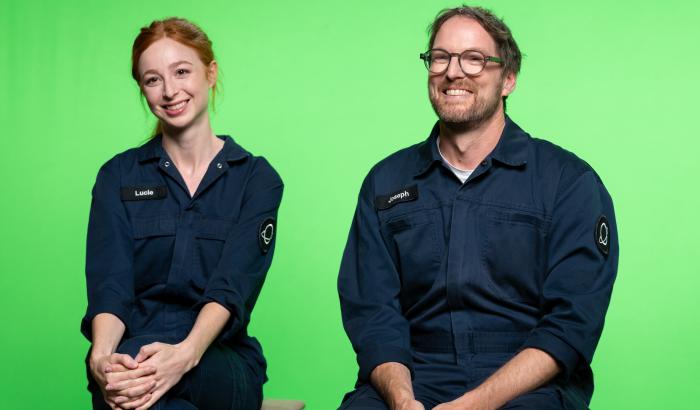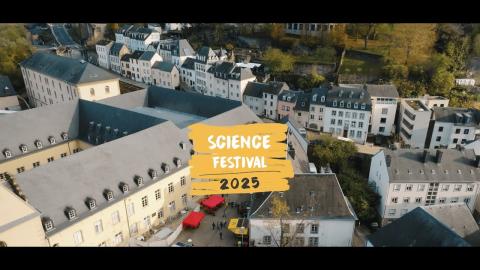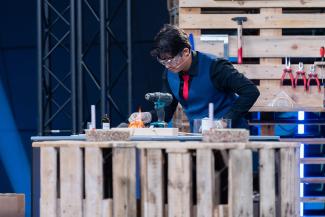
What is this challenge about?
In this challenge, the contestants have to start a fire and light a spray candle with it. They have various materials at their disposal. Once the fire is lit, they have to keep it alive long enough to actually light the candle.
|
Materials |
Number per Team |
|
Cordless screwdriver |
1 |
|
Scissors |
1 |
|
Pack of chewing gum paper (coated with aluminium) |
1 |
|
Permanganate |
1 |
|
Glycerine |
1 |
|
9V battery |
4 |
|
Steel wool |
1 |
|
Wood with notch |
1 |
|
8 mm wooden dowel |
1 |
|
Fire steel |
1 |
|
Candle |
1 |
|
Spray candle |
1 |
|
Cotton |
1 |
|
AA battery |
2 |
Infobox
There are various ways to start a fire. Here is a small list of the possibilities:
- Potassium permanganate and glycerol: When potassium permanganate (a strong oxidising agent) comes into contact with glycerol (an organic compound that acts as a reducing agent), an exothermic reaction can occur that takes place very quickly and releases a lot of heat. This reaction can lead to sudden ignition, as the oxidation of the glycerine by the potassium permanganate generates a high temperature. Caution: The mixture can lead to an uncontrolled fire. It is therefore very important to be extremely careful when working with these substances and to use a fireproof support (e.g. made of stone).
- Chewing gum paper and battery: The aluminium-coated paper must be cut with scissors, folded in half and cut into a triangle - but be careful! - When unfolded, both triangles should still have a connection of +/- 1 mm. Now connect both poles of the AA battery to the aluminium-coated side. As a strong current is now flowing, which is also highly concentrated at the narrowed point, this is where it gets hottest. So hot that the paper starts to glow. If you are skilful, you can light the cotton at this point.
- Steel wool and battery: When steel wool (which consists of thin iron fibres) comes into contact with the poles of a battery, especially a strong battery (such as a 9V battery), it ignites. Here is the process in detail: first there is a short circuit through contact; when the steel wool touches both poles of the 9 V battery, a closed circuit is created. As the fibres of the steel wool are very thin, they have a high electrical resistance. As a result, the fibres heat up strongly. The glowing iron immediately reacts with the oxygen in the air. This reaction is an oxidation and takes place very quickly, so that it looks as if the steel wool is ‘burning’. This produces iron oxide (Fe₂O₃ or Fe₃O₄) - i.e. rust. A solid iron wire or a metal block, on the other hand, would also conduct the current, but would have a much lower resistance and would not heat up as much. In addition, the surface area for the reaction with oxygen would be much smaller. Caution: Risk of injury: reaction produces sparks. There is also a risk of skin burns in the event of direct contact. Improper handling (e.g. by overheating the battery or creating too strong a short circuit) can lead to an explosion or the release of toxic substances.
-
Two other well-known methods are friction between soft wood and hard wood, e.g. applying the wooden dowel to the notched area on the wood using the cordless drill; and the use of fire steel in combination with metal (e.g. from scissors).
With all these experiments, safety measures must not be neglected! (gloves, safety glasses). Always have a suitable fire extinguisher or water ready in case of fire. A fireproof surface (e.g. made of stone) is also essential.
Do you want to know how the contestants from the show mastered this challenge?
Then take a look at episode no. 8! (Coming out this Sunday, 23.02.25)
What is the scientific background to this challenge?
How does a fire start? Three components are needed: Heat, fuel and oxygen. In most of the examples listed here, the triggered reaction generates enough heat to ignite the fuel.
When heat and fuel are present, it is important that there is also a constant flow of air to the fire: without oxygen, the flame would quickly go out. It is equally important to quickly add some easily flammable fuel. The fire must grow until it is stable.
One reason why water is used to extinguish fires is that there is almost no oxygen left under water. (However, sometimes the oxygen needed for combustion is present in the chemicals, so they can burn underwater!) Another reason is that if the fuel gets wet, the initial energy of the heat must be used to vaporise the water to dry the fuel. If the fire is not able to give off that much heat, then the water has successfully stopped the fire.
So, how do we create fire? With matches, we use friction to generate the initial heat to ignite the fuel. There are also oxygen-rich molecules in the head of the match, which ensure that the match is successfully ignited. The wooden part of the match serves as additional fuel that keeps the fire burning in combination with the oxygen from the surrounding air.
Lighters contain a piezo crystal that generates an electrical charge when struck by a small hammer. This charge travels through a wire and jumps across a gap, creating a small arc that ignites a flammable gas.
How can you make a fire in a survival situation? Depending on what materials are available, different solutions can be found. It is important to remember the three basic pillars of fire: Heat, fuel, oxygen. Find something that burns well; make sure that plenty of air can get into the designated area and create as much heat as possible in that area.
A few impressions from the eighth episode
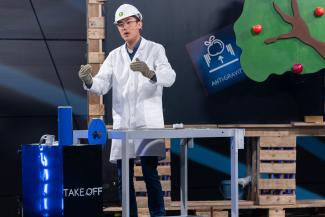

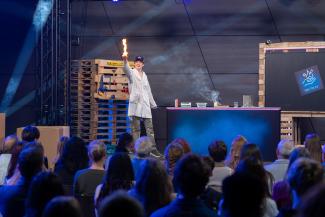
Author: Diane Bertel
Editor: Joseph Rodesch (FNR)
Fotos: Emmanuel Claude

